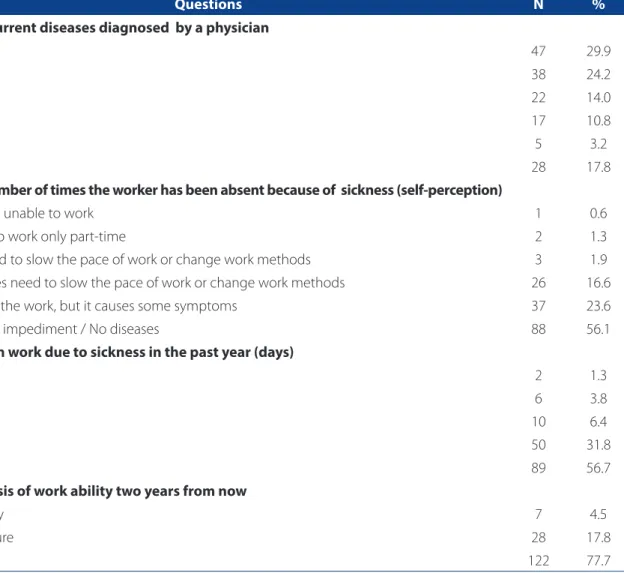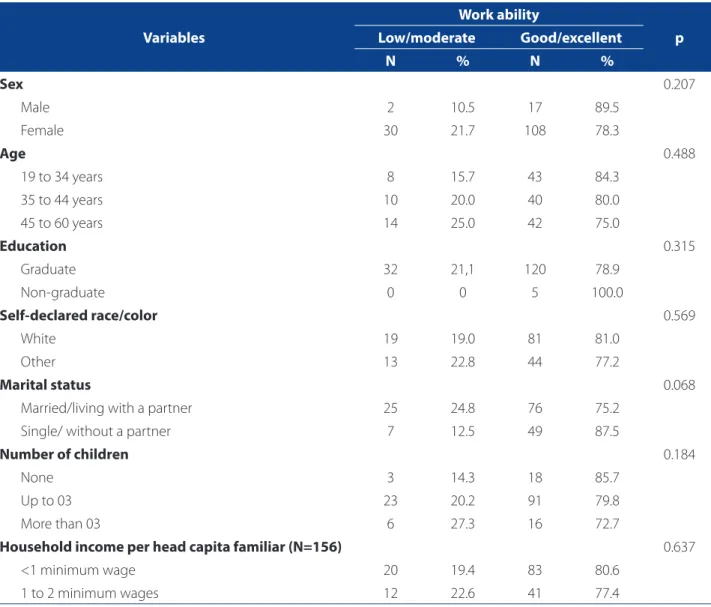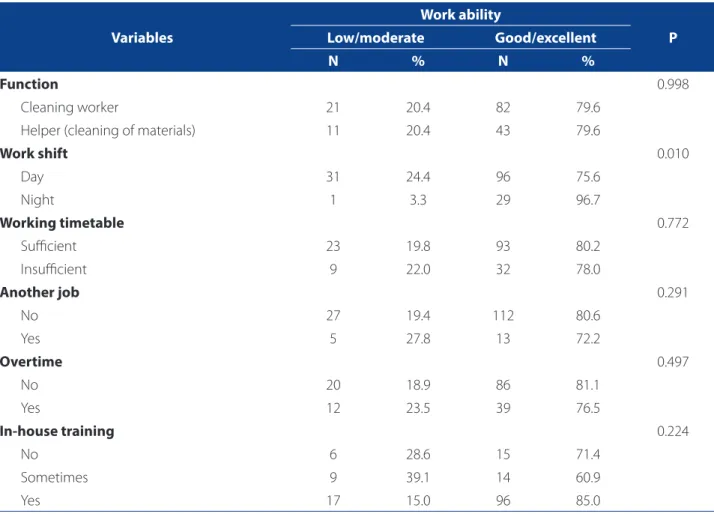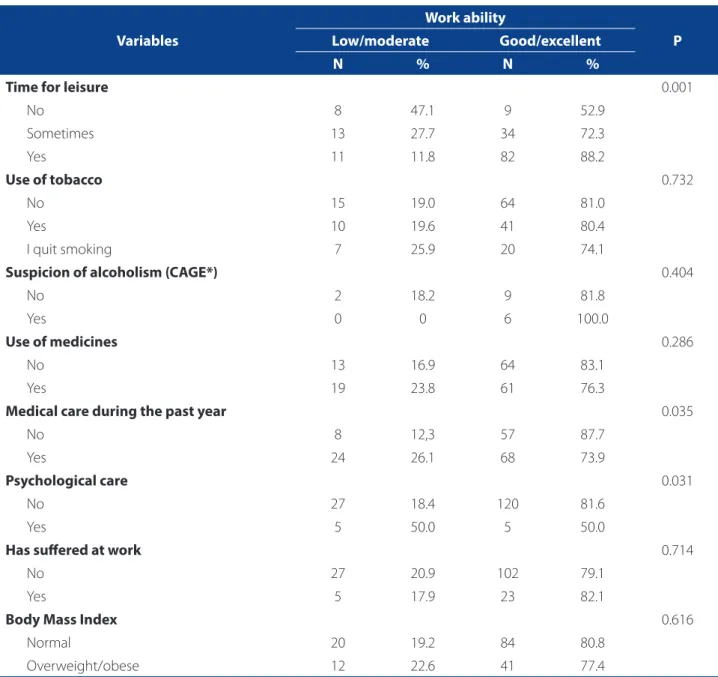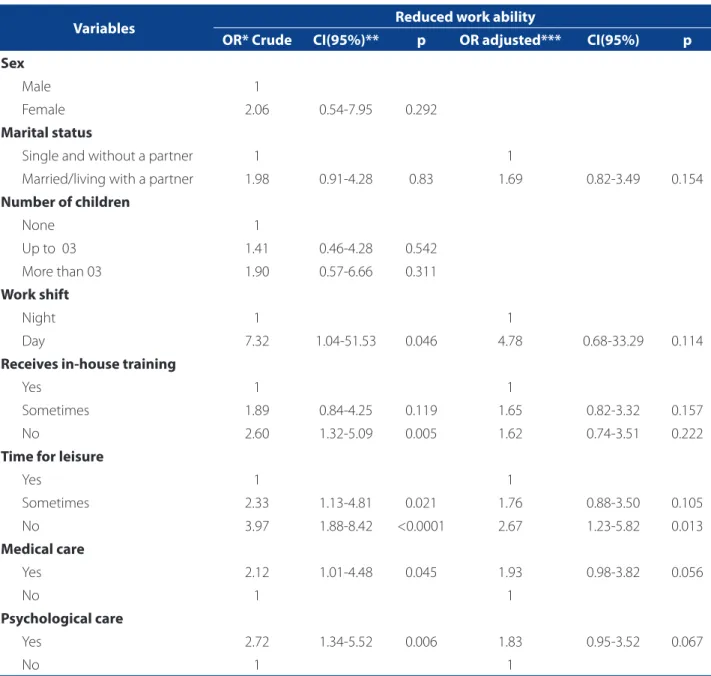Revista Gaúcha
de Enfermagem
DOI: http://dx.doi.org/10.1590/1983-1447.2014.04.50715
Work ability in hospital housekeeping
services and associated factors
a Masters degree in Nursing. Nurse at Hospital
Univer-sitário de Santa Maria, Santa Maria, RS, Brazil.
b PhD in Nursing. Professor at the Department and
Postgraduate Program in Nursing (PPGEnf) of Univer-sidade Federal de Santa Maria (UFSM), Santa Maria, RS, Brazil.
c PhD in Nursing. Retired Professor at Universidade
Federal de Santa Catarina, Florianópolis, SC, Brazil.
d Master student at the PPGEnf of UFSM. Nurse at
Hospital Universitário de Santa Maria, Santa Maria, RS, Brazil.
e Nursing student at UFSM. Scientifi c Initiation
Schol-arship (PROIC/HUSM), Santa Maria, RS, Brazil.
Marlize Tatsch Beltramea Tânia Solange Bosi de Souza Magnagob Ana Lúcia Cardoso Kirchhofc Cintia da Silva Marconatod Bruna Xavier Moraise
Capacidade para o trabalho no serviço
hospitalar de limpeza e fatores associados
Capacidad para trabajar en servicio de
limpieza hospitalaria y los factores asociados
ABSTRACT
This study aimed to measure the Work Ability Index of workers of a hospital housekeeping staff and identify the associated factors. Cross-sectional study conducted in 201 with 157 workers of the housekeeping staff of a university hospital in Rio Grande do Sul, Brazil. A questionnaire containing sociodemographic, labor and health variables and the Brazilian version of the Work Ability Index was used. As a result, 79.6% of the workers were classifi ed as having good/great work capacity. Mild mental (31.8%) and musculo-skeletal disorders (15.9%) were the most prevalent medical diagnoses. After some adjustments, the workers that did not have time for leisure showed a 2.67 times higher prevalence of having the work ability reduced (CI95%=1.23-5.82). The other variables lost their association with the outcome. Measures aimed at the maintenance of work ability and the practice of physical activity and training for postural care are indicated.
Descriptors: Nursing. Occupational health. Housekeeping, hospital. Work capacity evaluation.
RESUMO
Objetivou-se mensurar o índice de capacidade para o trabalho em trabalhadores do Serviço Hospitalar de Limpeza e identifi car os fatores a ele associados. Estudo transversal realizado em 2013, com 157 trabalhadores do serviço de limpeza de um hospital univer-sitário público do Rio Grande do Sul, Brasil. Utilizou-se um formulário contendo variáveis sociodemográfi cas, laborais, de saúde e a versão brasileira do Índice de Capacidade para o Trabalho. Como resultado, 79,6% dos trabalhadores foram classifi cados com boa/ ótima capacidade para o trabalho. Os distúrbios mentais leves (31,8%) e os musculoesqueléticos (15,9%) foram os diagnósticos médicos mais prevalentes. Após ajustes, os trabalhadores que não possuíam tempo para o lazer apresentaram uma prevalência 2,67 vezes mais elevada de ter a capacidade para o trabalho reduzida (IC95%=1,23-5,82). As demais variáveis perderam a associação. Indicam-se medidas de manutenção da capacidade laboral, como a prática de atividade física e capacitação para cuidado postural. Descritores: Enfermagem. Saúde do trabalhador. Serviço hospitalar de limpeza. Avaliação da capacidade de trabalho.
RESUMEN
Se objetivó medir el porcentaje de la capacidad para el trabajo en trabajadores del servicio de limpieza hospitalaria e identifi car los factores asociados a ella. Estudio transversal realizado en 2013, con 157 trabajadores de un hospital universitario de Rio Grande do Sul, Brasil. Se utilizó un cuestionario con variables sociodemográfi cas, laborales y de salud y la versión brasilera del Índice de Capaci-dad para el Trabajo. Como resultado, el 79,6% de los trabajadores fue clasifi cado como bueno/gran capaciCapaci-dad de trabajo. Trastornos mentales leves (31,8%) y musculoesquelético (15,9%) fueron los diagnósticos médicos más frecuentes. Después de los ajustes, los trabajadores que no tuvieron tiempo para ocio tenían un 2,67 veces mayor prevalencia reducir la capacidad de trabajar (IC95%=1,23-5,82). Las otras variables pierden su asociación. Se indican medidas de manutención de la capacidad laboral y práctica de actividad física y capacitación para el cuidado postural.
INTRODUCTION
Hospital Housekeeping Services (HHS) is essential in health institutions. The workers of the cleaning staff of a hos-pital are responsible for the organization of the environment, cleaning of equipment and facilities, contributing to reduce the risk of infection and promoting patient safety(1).
In the hospital setting, the workers of a hospital house-keeping staff are usually outsourced. There are many ref-erences in the literature to the fact that these workers, outsourced(2) or not(3), enter the labor market early, have low level of education and are underpaid. These workers develop sanitizing and cleaning activities, through the use of mechanical and chemical processes(1). A remarkable fea-ture of this work is the muscular eff ort required to lift and transport weights, perform repetitive movements and in tilting movements of the body. Also, the referred workers are exposed to chemicals and workplace accidents. These daily exposures may damage health(4) and the ability to de-velop their work activities(5).
Work ability is directly related to the possibility of per-forming activities that involve physical, mental and func-tional aptitudes (5). It is defi ned as “how well a worker is now, or will be in the near future, and how capable he or she is to perform his or her work, depending on their requirements, health status and physical and mental con-ditions”(5). The measurement is made by the Work Ability Index (WAI), which comprises individual and labor aspects. The determination of the WAI is based on the answers to a series of questions, considering the physical and men-tal requirements of the work, the health status and the re-sources used by the worker. The results of this assessment can support the development of health care programs(5). Since this population is usually under the direct or indirect management of nurses, these should be responsible for such assessment.
To support this study, we carried out a systematic search at LILACS database using descriptors “Work Capac-ity Evaluation” AND “Occupational Health”, and 21 articles were identifi ed. After a critical reading of the abstracts, it was found that none of them involved workers of a hospital housekeeping staff . In another search at this database us-ing the descriptor “Hospital housekeepus-ing”, 51 studies were found. Of these, one assessed WAI(3), and showed that it was low in 14.5% of the workers aged 50 to 60 years and in those aff ected by a greater number of diseases. The search at PubMed, using the strategy “Work Capacity Evaluation” AND “Housekeeping, Hospital”, led to the same study(3).
Therefore, in view of the individual and labor character-istics and the early labor market entry of this population,
as well as the predictive value of the work ability index, (WAI) the present study consists in a dissertation(6) with the following research questions: How is the work capacity of professionals of the housekeeping staff of a university hos-pital of Rio Grande do Sul? What are the factors associated to this capacity? It is believed that the diagnosis discussed here may contribute to the development of health promo-tion programs for this populapromo-tion.
Thus, we aimed to measure the work ability index in workers of the housekeeping staff of a hospital and identify the related factors.
METHOD
Cross-sectional study approved by the Research Eth-ics Committee of the institution, under CAAE 13106313. 1.0000.5346, on February 26, 2013, in a public university hospital of Rio Grande do Sul, Brazil. The workers of the housekeeping staff are distributed as follows: in teams of cleaning workers (maintenance cleaning and terminal dis-infection in all sectors) and cleaning helpers for cleaning materials (equipment and instruments).
The study population was composed of the total num-ber of workers (N=161). Two (1.2%) were excluded because they were on sick leave. Of the eligible population (159), 157 completed the questionnaire (98.7%). The losses (1.3%) resulted from refusals.
Data collection was performed between March and April 2013 by a team of previously trained graduate stu-dents, postgraduate students and nurses. The worker was invited to participate in the study and after agreement, signed the Free Informed Consent, according to Resolu-tion 466/12. The participants answered the quesResolu-tionnaire in the workplace during their shift (morning, afternoon or evening), in a separate room. Given the literature(3) evidence on the low level of education of this group of workers, the interviewer read the questions and the sponse options, ticking the response issued by the re-spondent. Thus, for quality control purposes, the worker also had a form (questionnaire) to follow the reading of the questions and visualize the possible response options before issuing them.
The Part 2 of the form was the Brazilian version of the WAI(5) (dependent variable), developed by a group of re-searchers of the Finnish Institute of Occupational Health, in 1997. The WAI consists of seven items that comprise: cur-rent ability to meet work requirements, diagnosed diseas-es, estimatednumber of times the worker has been absent because of sickness, absence from work due to sickness in the past year, own prognosis of work ability and mental re-sources used (enjoy daily activities, feel alive and alert, have hopes for the future)(5).
The database was organized with the Epi-info® soft-ware, using double data entry. After correction of errors and inconsistencies, analysis was carried out with the PASW Statistics® (Predictive Analytics Software). Descriptive sta-tistics (measures of position and dispersion, according to normal or non-normal data distribution) was used in the analysis of continuous variables. The categorical variables were assessed in absolute and relative frequencies.
The WAI score was constructed by summing the points assigned to each one of the seven items, according to the instructions in the manual(5). The score ranged from 7 to 49 points, as follows: 7 to 27 (low), 28 to 36 (moderate), 37 to 43 (good) and 44 to 49 (excellent work ability). For bivariate and multivariate analyzes, the categories Low, Moderate, Good and excellent ability were dichotomized into Low/ moderate (07 to 36) and Good/excellent work ability (37 to 49).
For multivariate analysis, Poisson Regression model was used, being expressed by the Prevalence Ratio (PR) and its respective confi dence intervals (CI95%). All the variables associated to the outcome at a signifi cance level of 0.25 were considered confounding variables in the crude and adjusted models. In all the analyzes, the association was considered statistically signifi cant when p≤0.05.
Assessment of the internal consistency of the WAI, measured by measured by Cronbach’s alpha coeffi cient, showed a satisfactory consistency of the instrument (α= 0.73). Kolmogorov-Smirnov test was used to assess data adherence to normal distribution.
RESULTS
Most workers were women (87.9%), with average age of 39.9 years (±9.8), minimum 19 and maximum 60 years, who declared themselves to be white (63.7%); married and/or living with a partner (64.3%), having one child (28.0%); have completed secondary education (38.9%) and average household income per head of less than one na-tional minimum wage (mean 0.86 (±0,47); minimum 0.20 and maximum 2.95 wages).
It was found that most Cleaning Workers (65.6%) have been working in the institution in average for 32.5 months (±48,9) and in the sector for 24.5 months (±39.7). The per-centage of cleaning workers who performed their activities in the day shift was (80.9%); (72.6%) reported that the num-ber of workers in the working timetable was adequate and (65.9%) were satisfi ed with their pay. A higher percentage (88,5%) reported not having another job, (67.7%) did not work overtime and (72%) did not receive in-house training. The next data concern health variables: (50.3%) cleaning workers have never smoked l (89.2%) did not drink alcohol and (98,7%) did not take drugs. In the last 12 months prior to the study, 58.6% required medical care and 6.4%, need-ed psychological care. Of these, 51% were taking mneed-edicines. The average hours of sleep per day were 7.1 hours (±1.6) and 59.2% reported having time for leisure activities. Regarding the analysis of the Body Mass Index (BMI), 1.9% were under-weight, 27.4% had normal weight and 70.7% had increased body weight, distributed as follows: 36.9% pre-obese and 33.8% with obesity grades I, II and III.
When each question of the WAI was separately ana-lyzed, the following results were obtained according to the responses of the participants. Asked about their current work ability level, considering a 0-10 scale, with zero indi-cating inability to work and 10 the best degree of capacity, 36.6% rated themselves at the highest level (10). The aver-age value in this item was 8.61 (±1.57), minimum zero and maximum 10.
Concerning the current work ability considering the physical and mental requirements, respectively 44.4% and 63.5% of these workers rated it as good. A small percent-age of workers rated their current ability to work as low re-garding the physical (6.3%) and mental (3.2%) requirements. Of those who became sick, the average number of diseases diagnosed by the physician was 2.24 (±2.67), ranging from one to 15 diseases. Mild mental disorders (31.8%) and musculoskeletal disorders (15.9%) were the most prevalent medical diagnoses.
Regarding satisfaction with daily activities, (30.3%) replied that they were almost always satisfi ed; 54.8%, were always satisfi ed; 11.6%, sometimes; and 2.6%, rarely. Re-garding feeling active and alert, for 28.4%, this occurred almost always; for 64.5%, always; for 6.5%, sometimes; and for 0.6%, rarely. Regarding the item feeling hope for the future, 71% of the workers replied that they felt continu-ally hopeful ; 18.7%, almost always; 7,7%, sometimes; and 2.6% of them rarely felt hope for the future.
abil-ity; 25 (16.6%), with moderate abilabil-ity; 69 (43.9%), with good ability; and 56 (35.7%), with excellent work ability. When the categories were dichotomized, 32 (20.4%) had low/ moderate ability and 125 (79.6%), good/excellent ability.
None of the sociodemographic variables was associat-ed to work ability (p>0.05).
Most (96.7%) workers of the night shift obtained a sig-nifi cant classifi cation of good/excellent for work.
Workers classifi ed in the good/excellent category: 88.2% of those who had time for leisure , 87.7% of those who did not require medical care and 81.6% of those who did not need psychological care.
After the adjustments, the workers who did not have time for leisure showed a 2.67 times higher prevalence of
having the work ability reduced. The other variables lost association.
DISCUSSION
The sociodemographic and economic characteristics of workers of a hospital housekeeping staff identifi ed here corroborate the results of other studies (3,8), except for age that showed the lowest mean(8-9). The profi le identifi ed in this study is consistent with the profi le of a group of work-ers that perform less paid jobs that do not require profes-sional qualifi cation (2).
The internal consistency of the WAI was satisfactory, corroborating the values obtained in other studies with
ad-Questions N %
Number of current diseases diagnosed by a physician
None 47 29.9
01 38 24.2
02 22 14.0
03 17 10.8
04 5 3.2
05 or more 28 17.8
Estimated number of times the worker has been absent because of sickness (self-perception)
I am totally unable to work 1 0.6
I am able to work only part-time 2 1.3
I often need to slow the pace of work or change work methods 3 1.9
I sometimes need to slow the pace of work or change work methods 26 16.6
Able to do the work, but it causes some symptoms 37 23.6
There is no impediment / No diseases 88 56.1
Absence from work due to sickness in the past year (days)
100 to 365 2 1.3
25 to 99 6 3.8
10 to 24 10 6.4
Up to 9 50 31.8
None 89 56.7
Own prognosis of work ability two years from now
It is unlikely 7 4.5
Not very sure 28 17.8
Very likely 122 77.7
Table 1. Distribution of workers of the hospital housekeeping staff of the hospital, according to the questions of the Work Ability Index. Santa Maria/RS, Brazil, 2013 (N=157).
ministrative workers. (10) (α=0.73) and electric utility workers (11) (α=0.72), though lower than the value obtained for
nurs-ing workers (α=0.90)(12).
Regarding the current work ability level,unlike this study, workers of the housekeeping staff of a university hospital in Paraná (Hospital Universitário do Norte do Paraná) showed a lower percentage with score 10 and higher per-centage with score 8 (30.6% vs 22.3%), indications of excel-lent work ability(8). These percentages for the highest scores of the WAU can be related to the selection process. Since it is a selection process, there is a greater possibility of hir-ing workers more able to perform their activities and, thus, with a higher score in this item (10).
Concerning the current work ability considering the physical and mental requirements, the workers rated it as good, but had more favorable outcomes in the mental requirements than in the physical requirements. The work performed by workers of a hospital housekeep-ing staff is predominantly physical, and there is greater re-duction in work ability when health impairment occurs as a result of physical labor (5).
Regarding the physical demands in hospital house-keeping, the hospital setting requires several types of cleaning, depending on the process used and the site to be cleaned, e.g. concurrent cleaning (daily cleaning and replacement of materials), the cleaning of fl oors and walk-Variables
Work ability
p Low/moderate Good/excellent
N % N %
Sex 0.207
Male 2 10.5 17 89.5
Female 30 21.7 108 78.3
Age 0.488
19 to 34 years 8 15.7 43 84.3
35 to 44 years 10 20.0 40 80.0
45 to 60 years 14 25.0 42 75.0
Education 0.315
Graduate 32 21,1 120 78.9
Non-graduate 0 0 5 100.0
Self-declared race/color 0.569
White 19 19.0 81 81.0
Other 13 22.8 44 77.2
Marital status 0.068
Married/living with a partner 25 24.8 76 75.2
Single/ without a partner 7 12.5 49 87.5
Number of children 0.184
None 3 14.3 18 85.7
Up to 03 23 20.2 91 79.8
More than 03 6 27.3 16 72.7
Household income per head capita familiar (N=156) 0.637
<1 minimum wage 20 19.4 83 80.6
1 to 2 minimum wages 12 22.6 41 77.4
Table 2. Distribution of workers of a hospital housekeeping staff , according to the Work Ability Index and sociodemo-graphic variables. Santa Maria/RS, Brazil, 2013.
ways and terminal cleaning (fl oors, walls and attachments) (13). In any of these types of cleaning, the physical
require-ments (weight lifting and loading, execution of repetitive motions, overloading of the joints, body posture, etc.) are part of the everyday work of a hospital housekeeping staff . This dynamics corroborates the reports on the musculo-skeletal diseases described. Among them, back pain radiat-ing down the back of the leg (sciatic) obtained the highest percentage of medical diagnoses (13.4%), and pain in the lower back was the most self-declared condition (26.1%). A review corroborates the fi ndings, demonstrating that musculoskeletal disorders were associated with physical stressors (inadequate postures and prolonged standing) and to psychosocial stressors (monotonous work, low po-tential for promotion)(4).
However, the workers that participated in the study showed a profile favorable to their health, since when asked whether their disease/lesion was an obstacle to
their current job, 56.1% reported they did not have such impediment. Health has a direct and positive im-plication in work ability, so that the healthier the em-ployee is, the greater his/her ability (5). The investigation of workers of a hospital housekeeping staff in the state of Paraná corroborates this evidence, since 88.9% of the workers who had not been absent from work showed a good/excellent WAI(8).
In this study, despite the favorable profi le, it should be taken into consideration that 43.3% of the workers had absences from work. Of this percentage, 31.8% for up to nine days, which is similar to the fi ndings of the hospital in Paraná (38%)(8). Another study developed in a public hos-pital showed high rates of absenteeism and occupational hazards in this population (13). Regarding absenteeism, it is important to stress that outsourced workers do not have job security, which could inhibit absence from work, even in the presence of symptom of any disease.
Variables
Work ability
P Low/moderate Good/excellent
N % N %
Function 0.998
Cleaning worker 21 20.4 82 79.6
Helper (cleaning of materials) 11 20.4 43 79.6
Work shift 0.010
Day 31 24.4 96 75.6
Night 1 3.3 29 96.7
Working timetable 0.772
Suffi cient 23 19.8 93 80.2
Insuffi cient 9 22.0 32 78.0
Another job 0.291
No 27 19.4 112 80.6
Yes 5 27.8 13 72.2
Overtime 0.497
No 20 18.9 86 81.1
Yes 12 23.5 39 76.5
In-house training 0.224
No 6 28.6 15 71.4
Sometimes 9 39.1 14 60.9
Yes 17 15.0 96 85.0
Table 3. Distribution of workers of a hospital housekeeping staff , according to the Work Ability Index and labor variables. Santa Maria/RS, 2013.
Regarding satisfaction, most workers said they were satisi ed with their daily activities, felt active, alert and had hopes for the future. The authors noted that only a minority of the workers exposed their job dissatisfaction, which may be underestimated10). A study suggests that, despite these workers, just like health professionals, experi-ence a high level of distress (coexistexperi-ence and daily confron-tation with the suff ering of patients), the awareness that their activities reduce the risk of infection and promote the
safety of patients(1) is a cause of satisfaction for them, even when they know that what they do is poorly recognized by many people (13). This satisfaction can contribute to the maintenance of high levels of WAI.
Therefore, a small percentage of workers was classifi ed as having low work ability. The percentages demonstrat-ed here are similar to those obtaindemonstrat-ed in other studies that found 15.2% and 25.2% for low/moderate ability and 69.4% to 84.8% for good/excellent ability(8,10). However, they diff er Variables
Work ability
P Low/moderate Good/excellent
N % N %
Time for leisure 0.001
No 8 47.1 9 52.9
Sometimes 13 27.7 34 72.3
Yes 11 11.8 82 88.2
Use of tobacco 0.732
No 15 19.0 64 81.0
Yes 10 19.6 41 80.4
I quit smoking 7 25.9 20 74.1
Suspicion of alcoholism (CAGE*) 0.404
No 2 18.2 9 81.8
Yes 0 0 6 100.0
Use of medicines 0.286
No 13 16.9 64 83.1
Yes 19 23.8 61 76.3
Medical care during the past year 0.035
No 8 12,3 57 87.7
Yes 24 26.1 68 73.9
Psychological care 0.031
No 27 18.4 120 81.6
Yes 5 50.0 5 50.0
Has suff ered at work 0.714
No 27 20.9 102 79.1
Yes 5 17.9 23 82.1
Body Mass Index 0.616
Normal 20 19.2 84 80.8
Overweight/obese 12 22.6 41 77.4
Table 4. Distribution of workers of a hospital housekeeping staff , according to the Work Ability Index and health-related variables/RS, Brasil, 2013.
Source: Research data.
from another study that reported higher percentages for low/moderate ability (46.4%) and lower percentages for good/excellent ability (53.6%)(3). Perhaps the type of em-ployment bond and the form of selection have impact on these percentage values.
Concerning the factors associated to work ability, only the lack of leisure time remained signifi cantly associated to reduced work ability. A study suggests that the higher the quality of physical and mental health, the better the work
ability(11). In this regard, physical labor may be an important institutional strategy to improve and maintain work ability, and the workers should be encouraged to do it (14).
CONCLUSION
It was found that 79.6% of the workers of a the house-keeping staff of a university hospital of Rio Grande do Sul were rated as having good/excellent work ability.
Mainte-Variables Reduced work ability
OR* Crude CI(95%)** p OR adjusted*** CI(95%) p Sex
Male 1
Female 2.06 0.54-7.95 0.292
Marital status
Single and without a partner 1 1
Married/living with a partner 1.98 0.91-4.28 0.83 1.69 0.82-3.49 0.154
Number of children
None 1
Up to 03 1.41 0.46-4.28 0.542
More than 03 1.90 0.57-6.66 0.311
Work shift
Night 1 1
Day 7.32 1.04-51.53 0.046 4.78 0.68-33.29 0.114
Receives in-house training
Yes 1 1
Sometimes 1.89 0.84-4.25 0.119 1.65 0.82-3.32 0.157
No 2.60 1.32-5.09 0.005 1.62 0.74-3.51 0.222
Time for leisure
Yes 1 1
Sometimes 2.33 1.13-4.81 0.021 1.76 0.88-3.50 0.105
No 3.97 1.88-8.42 <0.0001 2.67 1.23-5.82 0.013
Medical care
Yes 2.12 1.01-4.48 0.045 1.93 0.98-3.82 0.056
No 1 1
Psychological care
Yes 2.72 1.34-5.52 0.006 1.83 0.95-3.52 0.067
No 1 1
Table 5. Crude and adjusted analyzes of the factors associated to work ability in workers of a hospital housekeeping staff . Santa Maria/RS, Brazil, 2013.
Source: Research data.
nance actions are indicated for this group. However, 20.4% showed low/moderate ability. This group needs immedi-ate actions aimed to restore and improve their work ability. Of the assessed factors, only lack of leisure time was signifi -cantly associated to reduce work ability.
Institutional measures aimed to maintain, restore and improve work ability are recommended for both groups, as follows: elaboration of a program of physical activity with stretching and aerobic exercises and walking; training for postural self-care with the promotion of activ-ities to minimize the discomforts and the potential risk of injury resulting from improper body positions during work activities.
The challenge for the nurse manager or the member of the worker health team is to intervene in the reality of oc-cupational diseases of this population. The use of the WAI as a health indicator may help them in this task.
Although this study involved all the workers of the in-stitution, the size of the assessed population is one limita-tion of the study, as well as the fact that all the participants worked in the same institution. We suggest follow-up studies in further investigations, where institutions with diff erent processes of selection/admission are chosen, to evaluate the associations that were not identifi ed in the present study.
Acknowledgment: To CNPq, for the Edital Universal 2013, Processo no.481096/2013-2 and to UFSM, for the PROIC/HUSM
REFERENCES
1. Ministério da Saúde (BR), Agência Nacional de Vigilância Sanitária. Segurança do paciente em serviços de saúde: limpeza e desinfecção de superfícies. Brasília (DF); 2010.
2. Chillida MSP, Cocco MIM. Saúde do trabalhador & terceirização: perfi l de trabalhadores de serviço de limpeza hospitalar. Rev Latino-Am Enferm. 2004;12(2):271-6.
3. Andrade CB, Monteiro MI. Envelhecimento e capacidade para o trabalho dos trabalhadores de higiene e limpeza hospitalar. Rev Esc Enferm USP. 2007;41(2):237-44.
4. Charles LE, Loomis D, Demissie Z. Occupational hazards experienced by clea-ning workers and janitors: a review of the epidemiologic literature. Work. 2009;34(1):105-16.
5. Tuomi K, Ilmarinen J, Jahkola A, Katajarinne L, Tulkki A. Índice de capacidade para o trabalho. Fischer FM, tradutor. São Carlos: EdUFSCAR; 2005.
6. Beltrame M. Hábitos saudáveis e capacidade para o trabalho em trabalhadores do serviço hospitalar de limpeza [dissertação]. Santa Maria (RS): Programa de Pós-Graduação em Enfermagem, Universidade Federal de Santa Maria; 2014. 7. Ministério da Saúde (BR), Secretaria de Atenção à Saúde. Departamento de
Atenção Básica. Orientações para a coleta e análise de dados antropométricos em serviços de saúde: norma técnica do Sistema de Vigilância Alimentar e Nu-tricional – SISVAN. Brasília (DF); 2011.
8. Silva LG, Haddad MCL, Domansky RC, Vituri DW. Capacidade para o trabalho en-tre trabalhadores de higiene e limpeza de um hospital universitário público. Rev Eletr Enf. 2010;12(1):158-63.
9. Martarello NA, Benatti MC. Qualidade de vida e sintomas osteomuscula-res em trabalhadoosteomuscula-res de higiene e limpeza hospitalar. Rev Esc Enferm USP. 2009;43(2):422-8.
10. Martinez MC, Latorre MRDO. Saúde e capacidade para o trabalho em trabalha-dores de área administrativa. Rev Saúde Pública. 2006;40(5):851-8. 11. Martinez MC, Latorre MRDO, Fischer M. Validade e confi abilidade da
ver-são brasileira do Índice de Capacidade para o Trabalho. Rev Saúde Pública. 2009;40(3):525-32.
12. Fischer FM, Borges NS, Rotenberg L, Latorre MRDO, Soares NS, Rosa PLFS, et al. A (in)capacidade para o trabalho em trabalhadores de enfermagem. Rev Bras Med Trab. 2005;3(2):97-103.
13. Sznelwar LI, Lancman S, Wu MJ, Alvarinho E, Maria S. Análise do trabalho e serviço de limpeza hospitalar: contribuições da ergonomia e da psicodinâmica do trabalho. Rev Produção. 2004;14(3):45-57.
14. Lopes JA, Longo GZ, Peres KG, Boing AF, Arruda MP. Fatores associados à ativida-de física insufi ciente em adultos: estudo ativida-de base populacional no sul do Brasil. Rev Bras Epidemiol. 2010;13(4):689-98.
Author’s address:
Tânia Solange Bosi de Souza Magnago
Av. Roraima, 1000, prédio 26, Centro de Ciências da Saúde, Universidade Federal de Santa Maria
97105-900, Santa Maria, RS E-mail: tmagnago@terra.com.br
